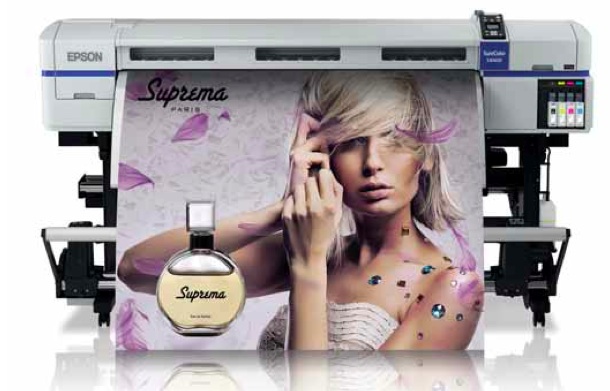Epson has a brand new solvent printer aimed firmly at the outdoor signage market. Nessan Cleary takes a look.
Epson launched the SureColor SC S30600 at the Fespa Digital show in Barcelona earlier this year and these are now beginning to trickle into the UK.

This is a 64in machine, designed for indoor and outdoor general signage applications, and uses one of Epson’s latest MicroPiezo TFP printheads. The head has eight channels, so that a single head can accommodate all four colours, with 360 nozzles per channel and two channels per colour. But the channels for each colour are not adjacent, as Richard Barrow, Epson’s senior product manager for signage, explains: “We can put down a block of colour with the maximum optical density but if you have all the nozzles firing at the same time you have to worry about drying. But by separating the channels we allow a little bit of time for the substrate to dry.”
Maximum resolution is Epson’s standard 1440 x 1440dpi. However, rather than supplying a Rip or a print driver, Epson is relying on its dealer channel to pair it with a suitable Rip or workflow depending on each customer’s needs. Most current Rips should be able to drive this but it's down to the individual Rip to determine the resolution for each job.
The inks themselves are light solvent, which Epson claims produce very low amounts of volatile organic compounds (VOCs), and can be used without ventilation in a standard office environment. They should be good for up to three year’s use outdoor, though Epson doesn’t guarantee this and it obviously varies depending on the substrate used.
Epson has gone back to the drawing board to design a complete new chassis for this printer, which will also form the basis of future products. The chassis itself is built on an automated robotic line, using laser welding. Barrow says: “It’s designed to produce a very stable platform so that when the print is in full production mode there’s no lateral movement.”
There’s a great deal of automation built in around the loading and media handling. This includes a jack system which is essentially two feeding levers at the rear of the machine that allow a single operator to load up to 40kg. There’s an optional system for taking rolls up to 80kg.
Epson has incorporated mini sensors into the paper feeding mechanism to alert the operator if there are any problems such as the paper lifting from the platen surface. There’s also a media loading switch which controls the nip rollers for feeding the paper, and which can be operated from either the front or rear of the printer so the operator doesn’t have to keep moving back and forth to check the progress when loading media. An automatic tensioning system adjusts the pressure on the substrate to compensate for the reduction in the size of the roll as it is used.
There’s an extra long heater across the length of the platen but if this doesn’t dry the ink fast enough then there’s also an optional additional drying unit which can be front mounted and blows cool air to the surface of the platen.
The maximum speed is 29.4m2/hr and Barrow says that this is good enough for billboard and some banner work. But a more realistic speed is 18m2/hr, which should produce prints suitable for point of sale work. The printer itself costs £11,995 but, in theory at least, all the attention to detail around the media handling should make this a much more productive machine than price and specifications alone can convey.

